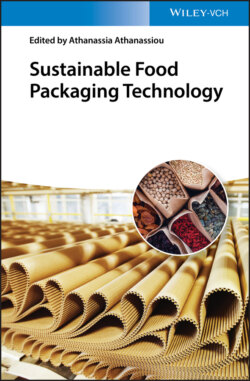Читать книгу Sustainable Food Packaging Technology - Группа авторов - Страница 13
1.1 Introduction to Polymers in Packaging
ОглавлениеAccording to the Food and Agriculture Organization of the United Nations (FAO), approximately one‐third of all food produced globally is lost or wasted [1]. Food waste is produced throughout the whole food value chain, from the household to manufacturing, distribution, retail, and food service activities. Taking into consideration the limited natural resources available, it is more effective to reduce food waste than to increase food production. For this reason, several efforts have been put for the development of more effective food packaging strategies [2, 3]. Packaging items have become essential to protect food from different environmental conditions. Depending on the type of food, the packaging article can be customized to prevent or inhibit microbial growth, avoid food decomposition by removing the entrance of light, oxygen, and moisture, or even to prevent spoilage from small insects. Additionally, novel packaging items can be monitored to give information about the quality of the packaged food, ultimately diminishing food waste during distribution and transport [4].
Common materials utilized for food packaging include glass, paper, metal, and plastic. The latter are nowadays more frequently used since they have a large availability at a relatively low cost and can display good characteristics for packaging items, such as mechanical strength, barrier properties, and transparency [4, 5]. The most commonly used petrochemical materials for packaging applications can be divided into various families:
Polyolefins and substitutes of olefins, such as low‐density polyethylene (LDPE) and linear low‐density polyethylene (LLDPE), polypropylene (PP), polystyrene (PS), oriented polystyrene (OPS), polyvinyl alcohol (PVOH), polyvinyl chloride (PVC), and polyvinylidene chloride (PVDC). Polyolefins are frequently used in reusable bags, paper cups, and stand‐up pouches, while substitutes of olefins such as PVC are popularly used in cling films and in some prepackaged meals.
Copolymers of ethylene, such as ethylene‐vinyl acetate (EVA) and ethylene‐vinyl alcohol (EVOH), are typically used to make lid films for trays and barrier interlayers.
Polyesters, such as polyethylene terephthalate (PET) and other aliphatic and aromatic polyesters, are mainly used to make water bottles.
Polyamides (PAs) are commonly employed in films or trays for food products that are very sensitive to oxygen.
Most of these materials are made by condensation or addition polymerization of monomers of hydrocarbon or hydrocarbon‐like raw materials, which means that due to their fossil‐based nature and high chemical stability, they are not biodegradable and will accumulate in landfills over the years, causing a negative impact on the environment. Although several recycling strategies are currently being carried out, packaging materials are often contaminated with leftover food, making recycling economically inconvenient and thus unviable. In 2010, primary plastic production was 270 million tons, yet plastic waste was 275 million tons since plastics produced in previous years entered the waste stream, where the sector of packaging was the highest producer of plastics, that is, 146 million in 2015. This has led to an increase in the number of campaigns requesting the removal of single‐use plastics, with the European parliament aiming to ban single‐use plastic cutlery, cotton buds, straws, and stirrers by 2021. Such environmental awareness and implementation of stringent environmental regulations are leading to research for alternatives to food packaging materials and, thus, efforts are being directed, at both academic and industrial levels, at the use of bioplastics in a variety of consumer products.
